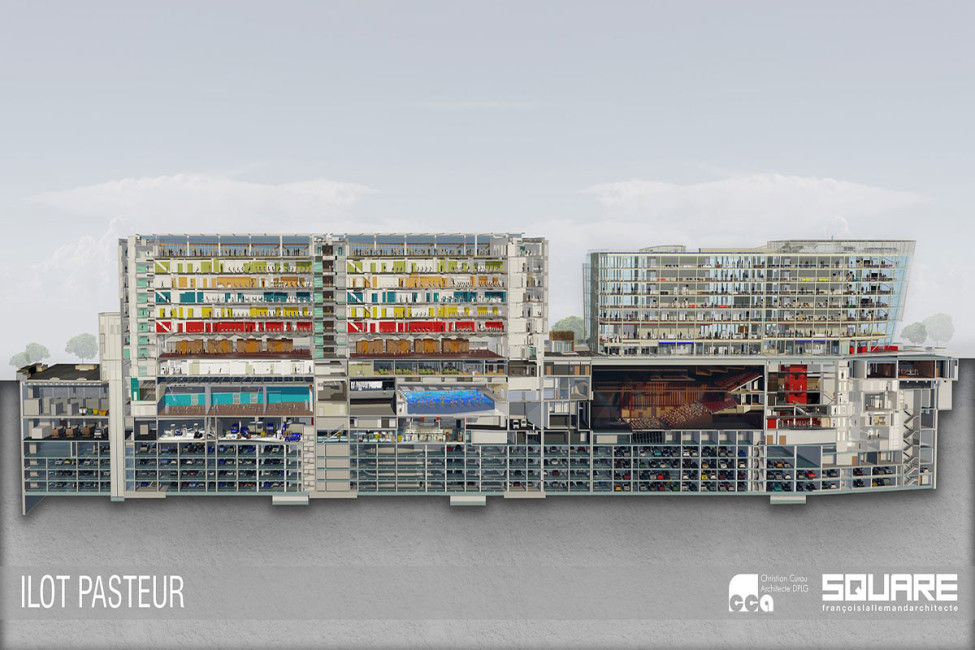The Ilot Pasteur: an Urban Game of Tetris
The Pasteur Island – Ilot Pasteur - one of the last remaining SNCF abandoned grounds, comprises 10 programmes covering an area of 118,000 m². The cost of the works is estimated at €341 million.
"Only in Monaco would you see something like this! We've got 10 programmes on an unusual plot of railway wasteland, 250 metres long and 30 metres wide" enthuses architect François Lallemand, who is working with Christian Curau on the 118,000 m² development. His company, Square, won the town planning bid 11 years ago and has since been working on this huge project, which includes a secondary school for 1,500 pupils, a 300-seat amphitheatre, a gymnasium, a swimming pool, a media library, nearly 8,000 m² of office space, a 1,500-seat multi-purpose hall (the size of an Olympic swimming pool!), a waste sorting centre for recycled urban waste, a mail sorting centre and a 900-space car park.
The first mixed concrete and steel structure in Monaco
The project involves a number of specific technical features. ‘It's the first time we've built a mixed concrete and steel structure in Monaco,’ continues François Lallemand. The bridge structure with a steel framework required four large metal lattice girders for each span to form the skeleton of the building. That's as many tonnes of steel as the Eiffel Tower... Another achievement: ‘At certain times, the site looked like an unbelievable cathedral. We used up-down technical solutions: we were building at the top while we were working at the bottom’, says the architect, recalling that the road passed at an altitude of around 22 metres at sea level, we went down to minus 17 and went back up to +60... Time was short: after preparatory work, the site, which started in 2019, suffered a few delays due to changes in the programme and an invitation to tender that was declared unsuccessful. The consultation was extended to French and Spanish companies, and in the end it was Fayat that took charge of this very special project. And there was a crucial constraint for a major building project in the heart of an industrial and business district: avoiding nuisance. ‘We did everything we could to prevent any noise and not disturb the neighbourhood, notably by installing 6-metre-high acoustic walls.
Intelligent building modelling
A small technological revolution: the architects in charge of the project and the partners in the project management team set up a unit to co-produce the 3D Building Information Model (BIM). ‘We were the first in the Principality to work with BIM processes on an intelligent model of the building. We built it digitally before constructing it in real life,’ explains François Lallemand, who is delighted with this development in his profession. ‘An immense database enables architects and engineers to work on the same digital model. For example, the ‘fluid’ model includes everything that makes the building function (electricity, ventilation, heating, water, drainage) and everything is calculated in real time. The advantage is that we can create computer-generated images and walk around the model like a video game...’.
At the end of the project, the Public Works Department will have a copy of this model showing everything that has been done on the Pasteur block. ‘If you want to change a light bulb, all you have to do is click on it and the associated technical data sheet will appear. It's a giant instruction manual that's essential for operation. For decades, these documents of executed works were delivered in hundreds of boxes containing all the building plans... With BIM, you have the building in miniature in your pocket!’ Even better, the BIM model of the Charles-III secondary school includes horizontal and vertical movement, lifts and emergency equipment such as dry columns for connecting fire hoses in the event of a fire. ‘The idea is to be able to engage emergency services as effectively and quickly as possible. So we know where the fire is burning, but above all we know how to get there,’ Lieutenant-Colonel Yvrard, Chief Officer of Monaco's fire service, told Monaco-Matin. ‘It's a world-first to have dynamically connected a fire detection system to a digital model, with direct relay of information to the emergency services,’ Adrien Le Bret, Deputy Director of the Department of Public Works, told the press.

